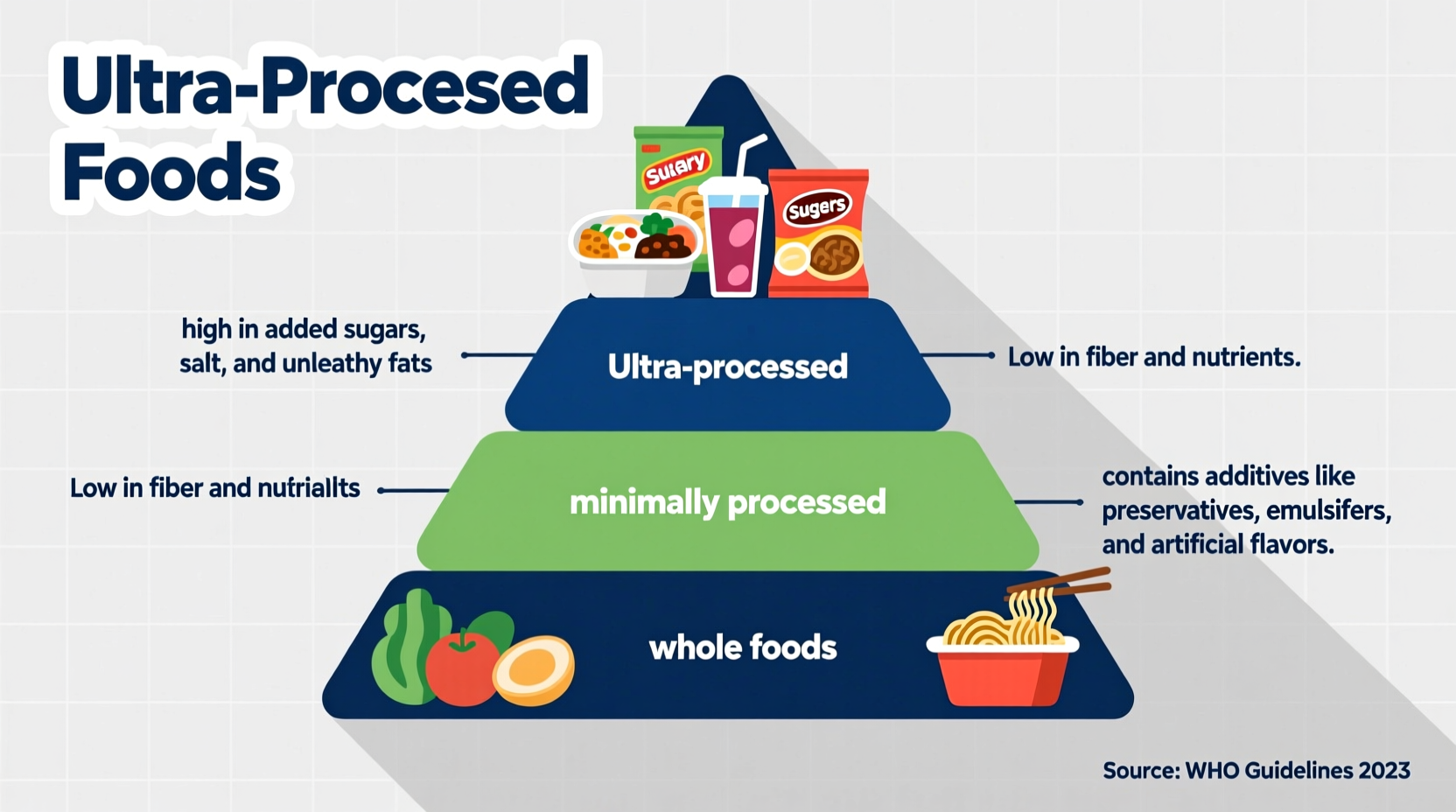Understanding Ultra-Processed Foods: What You Need to Know
When you're scanning grocery store aisles or reading food labels, recognizing ultra-processed foods can significantly impact your dietary choices. These products dominate modern food environments, making up more than 60% of calories consumed in countries like the United States according to CDC data. Unlike minimally processed foods that retain their natural structure, ultra-processed items undergo multiple industrial processes that fundamentally alter their composition.
The NOVA Classification System Explained
To properly understand what qualifies as ultra-processed, we need to examine the scientific framework used by researchers worldwide—the NOVA classification system developed by nutrition scientists at the University of São Paulo. This system categorizes foods based on their degree and purpose of processing, not just nutritional content.
| NOVA Group | Processing Level | Examples | Typical Ingredients |
|---|---|---|---|
| Group 1 | Unprocessed or minimally processed | Fresh fruits, vegetables, eggs, milk, meat | Natural state or altered by cleaning, freezing, drying |
| Group 2 | Processed culinary ingredients | Salt, sugar, oils, butter, vinegar | Extracted from Group 1 foods for cooking |
| Group 3 | Processed foods | Canned vegetables, cheese, freshly baked bread | 2-3 ingredients, preservation purpose |
| Group 4 | Ultra-processed foods | Soda, packaged snacks, instant noodles, frozen meals | 5+ ingredients including additives, little whole food |
This classification helps distinguish between healthy processing (like freezing vegetables to preserve nutrients) and industrial processing that creates products barely recognizable from their original ingredients. The critical difference lies in both the number of ingredients and the presence of substances not used in home cooking.
How to Spot Ultra-Processed Foods in Your Kitchen
Identifying ultra-processed foods requires looking beyond marketing claims like "natural" or "healthy". Instead, examine these key characteristics:
- Long ingredient lists with unfamiliar chemical-sounding names
- Multiple forms of sugar (high-fructose corn syrup, maltodextrin, dextrose)
- Emulsifiers and stabilizers (lecithin, carrageenan, xanthan gum)
- Artificial colors and flavors
- Little visible whole food content
Consider breakfast options: a bowl of plain oatmeal with fresh berries (Group 1) versus sugary breakfast cereal with 15+ ingredients including artificial colors and flavors (Group 4). The difference extends beyond ingredients to how these foods affect satiety and metabolic response. Research published in Cell Metabolism shows people consume approximately 500 more calories daily when eating ultra-processed diets compared to whole food diets.

Common Ultra-Processed Food Categories
These products permeate modern food environments. Watch for these everyday examples:
- Sweetened beverages: Sodas, energy drinks, flavored coffees
- Mass-produced baked goods: Packaged cookies, cakes, and doughnuts
- Instant meal products: Ramen noodles, boxed macaroni and cheese
- Processed meats: Hot dogs, chicken nuggets, deli meats
- Prepared frozen meals: Many "healthy" microwave dinners
- Snack foods: Chips, candy bars, packaged popcorn
It's important to recognize that not all packaged foods are ultra-processed. Canned beans without additives, plain frozen vegetables, and plain yogurt fall into lower NOVA categories. The distinction lies in the extent of industrial formulation rather than packaging alone.
Health Implications: What Research Shows
Over the past decade, numerous studies have examined the relationship between ultra-processed food consumption and health outcomes. A comprehensive review in The BMJ analyzed data from more than 40 studies involving 10 million participants across multiple countries. The findings reveal consistent associations between high ultra-processed food consumption and:
- Increased risk of obesity and weight gain
- Higher incidence of cardiovascular disease
- Elevated risk of type 2 diabetes
- Potential links to certain cancers
- Negative impacts on gut microbiome diversity
Researchers at the National Institutes of Health conducted controlled feeding studies showing that people naturally consume more calories and gain weight when provided with ultra-processed diets compared to unprocessed diets, even when meals are matched for calories, sugar, fat, and fiber. The theory is that ultra-processed foods disrupt normal hunger and fullness signaling due to their engineered texture, rapid digestion, and hyper-palatable combinations.
Practical Strategies for Reducing Ultra-Processed Foods
Transitioning away from ultra-processed foods doesn't require perfection—small changes create meaningful impact. Try these evidence-based approaches:
Smart Grocery Shopping
Focus your shopping on the perimeter of the store where fresh produce, dairy, and meats are typically located. When venturing into center aisles, look for products with 5 or fewer recognizable ingredients. The Harvard T.H. Chan School of Public Health recommends applying the "short ingredient list" rule as a practical guideline.
Simple Meal Swaps
Gradually replace ultra-processed items with minimally processed alternatives:
- Instead of sugary cereal: Oatmeal with fresh fruit
- Instead of packaged snacks: Nuts and seeds
- Instead of frozen meals: Batch-cooked grains with vegetables
- Instead of soda: Sparkling water with citrus slices
Reading Labels Effectively
When evaluating packaged foods, prioritize products where the first three ingredients are whole foods. Be wary of products listing multiple forms of sugar in the first five ingredients. The FDA's updated nutrition labels now group different types of added sugars together, making this easier to spot.
Moving Forward: A Balanced Approach
Complete elimination of ultra-processed foods isn't realistic or necessary for most people. The goal is reducing consumption to reasonable levels while increasing whole food intake. Public health experts recommend aiming for ultra-processed foods to constitute less than 20% of daily calories—a significant reduction from current averages in many Western countries.
As food science continues evolving, new research may refine our understanding of processing effects. Current evidence consistently points to whole and minimally processed foods as the foundation of healthy dietary patterns across diverse cultural traditions worldwide.











 浙公网安备
33010002000092号
浙公网安备
33010002000092号 浙B2-20120091-4
浙B2-20120091-4